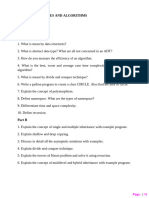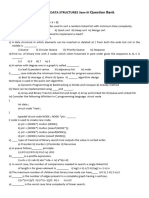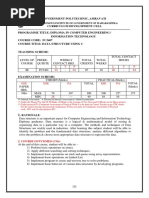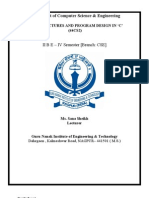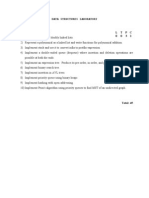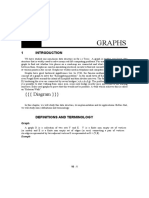CS1201 Data Structures
Uploaded by
sureshCS1201 Data Structures
Uploaded by
sureshCS1201 DATA STRUCTURES
Department of Computer Science & Engineering
Sub Code/ Subject: CS1201 / Data Structures
Year / Sem: II/III
UNIT I - PROBLEM SOLVING PART A (2 Marks)
1. Define Program 2. Define Algorithm 3. Define Problem Definition Phase
4. What are the problem solving strategies? 5. Define Top Down Design. 7. Define Program Verification. 8. Define Input & Output Assertion. 9. Define Symbolic Execution 10. Define Verification Condition 11. Define the qualities of good algorithm. 12. Define Computational Complexity. 13. What is O notation?
6. What is the basic idea behind Divide & Conquer Strategy?
14. What is Recursion? Explain with an example.
15. List out the performance measures of an algorithm. PART B
1. Explain in detail the steps involved in Top down Design. 2. Write the verification condition of a program segments with a. Straight line statements b. Branches c. Loops
aa na va
a. S=1+(1/2)+(1/3)+.
3. Write a short notes on efficiency of an algorithm. 5. (a) Develop an algorithm to compute the sums for the first n terms
4. Write a short notes on analysis of an algorithm.
(b) Discuss in detail about the implementation of the algorithm. 6. (a) Write an algorithm to reverse the digits of a decimal number. (b) Write an algorithm to compute the Fibonacci series for n terms
n. co m
(16) (4) (6) (6) (16) (16) (8) (8) (8) (8)
CS1201 DATA STRUCTURES
UNIT II - LISTS - STACKS AND QUEUES PART A (2 Marks)
1. Define ADT 2. List out the operations of the list ADT. 3. Define Dequeue. 4. How do you push & pop elements in a linked stack. 5. Convert the infix expression a+b*c+(d*c+f)*g to its equivalent postfix expression. 6. List the characteristics of stack. 7. List out the applications of stack. 9. Define circular queue. 10. Define cursor space.
PART B
1. Write a program in C to return the position of an element X in a List L. 2. (a) State & explain the algorithm to perform Radix Sort.
n. co m
H+1
8. Define linked list & its types.
(16) (8) (8) (16) (8) (8)
(b) Write a Program in C to create an empty stack and to push an element into it.
4. (a) Write a c program to multiply two polynomials. (b) Write a c program to add two polynomials.
5. (a) Write an algorithm to convert infix to postfix expression and explain it with example (8) (b) Write an algorithm to evaluate a postfix expression and explain it with example (b) Write an algorithm for insertion and deletion operation in a circular queue (8) (8)
6. (a) Write an algorithm to check given expression contains balanced parenthesis or not.(8)
1. Explain the representation of priority queue 2. Compare the various hashing Techniques. 3. List out the steps involved in deleting a node from a binary search tree.
4. What is binary heap? 5. Define Binary search tree. 6. List out the various techniques of hashing 7. Define hash function. 8. Show that maximum number of nodes in a binary tree of height H is 2 9. Define hashing. 10. Define AVL tree. 1.
aa na va
3. Explain how queues can be implemented using Arrays
UNIT III - TREES
PART A (2 Marks)
CS1201 DATA STRUCTURES
PART B
1. (a) Construct an expression tree for the expression A+(B-C)*D+(E*F) (b) Write a function to delete the minimum element from a binary heap it. 3. Explain in detail about Open Addressing 4. Explain in detail insertion into AVL Trees 5. Write a recursive algorithm for binary tree traversal with an example. (8) (8) (16) (16) (16) (16)
2. Write a program in C to create an empty binary search tree & search for an element X in
6. Write an algorithm for initializing the hash table and insertion in a separate chaining (16)
UNIT IV - SORTING PART A (2 Marks)
2. What is the worst case complexity of Quick sort?
1. Mention the time complexities of merge sort & shell sort. 3. State the algorithmic technique used in Merge sort.
4. What is the average number of inversions in an array of N distinct numbers?
6. Develop pseudo code that will illustrate the process logic in insertion sort. 7. What is the best case time complexity of the quick sort algorithm? 8. Define external sorting.
9. State the algorithmic technique used in Increment Diminishing Sort. 10. Define sorting.
1. State & explain the algorithm to perform Heap sort. Also analyze the time complexity of
aa na va
of N distinct items?
5. What is the average number of comparisons used to heap sort a randomized permutation
PART B
the algorithm
n. co m
(16) (16)
2. Write a C program to perform Merge sort and analyze time complexity of the algorithm.
3. State & explain the algorithm to perform Quick sort. Also analyze the time complexity of the algorithm. (16) 4. State & explain the algorithm to perform Shell sort. Also analyze the time complexity of the algorithm. 5. State & Explain External sorting Algorithm Two Way Merge, Multiway Merge. (16) (16)
CS1201 DATA STRUCTURES
UNIT V - GRAPHS PART A (2 Marks)
1. Explain the topological sort. 2. Define NP hard & NP complete problem. 3. Prove that the number of odd degree vertices in a connected graph should be even. 4. What is an adjacency list? When it is used? 5. What is an activity node of a graph? 6. Define Breadth First Search. 7. Define Depth First Search. 8. Define Minimum Spanning Tree.
10. Define Biconnectivity.
PART B
with example.
1. Formulate an algorithm to find the shortest path using Dijkstras algorithm and explain (16) (16) (8) (8) 2. Explain the minimum spanning tree algorithms with an example. 3. (a) Write short notes on Biconnectivity.
aa na va
(b) Write an algorithm for Topological Sort of a graph.
4. 5.
Write and explain weighted and unweighted shortest path algorithm Explain the various applications of Depth First Search.
n. co m
-------------
9. Define Shortest Path of a graph.
(16) (16)
You might also like
- Question Bank: Subject: Data Structures and AlgorithmsNo ratings yetQuestion Bank: Subject: Data Structures and Algorithms6 pages
- Data Structures Part - A (Shortanswer Questions) : Vemu Institute of TechnologyNo ratings yetData Structures Part - A (Shortanswer Questions) : Vemu Institute of Technology6 pages
- CS3301 Data Stuctures Important QuestionsNo ratings yetCS3301 Data Stuctures Important Questions7 pages
- Cs3301 Data Structure Important QuestionNo ratings yetCs3301 Data Structure Important Question8 pages
- Data Structure Most Important Question All Unit (1)No ratings yetData Structure Most Important Question All Unit (1)7 pages
- Data Structures and Algorithms - CD3291 - Important QuestionsNo ratings yetData Structures and Algorithms - CD3291 - Important Questions6 pages
- Gujarat Technological University Computer Engineering (07) / Information Technology (16) / Information & Communication TechnologyNo ratings yetGujarat Technological University Computer Engineering (07) / Information Technology (16) / Information & Communication Technology3 pages
- Cse-Nd-2021-Cs 8391-Data Structures-20630293-40388 (CS8391)No ratings yetCse-Nd-2021-Cs 8391-Data Structures-20630293-40388 (CS8391)3 pages
- WWW - Manaresults.co - In: (Common To CSE, IT)No ratings yetWWW - Manaresults.co - In: (Common To CSE, IT)2 pages
- Mca1002 - Problem Solving Using Data Structures and Algorithms - LTP - 1.0 - 1 - Mca1002No ratings yetMca1002 - Problem Solving Using Data Structures and Algorithms - LTP - 1.0 - 1 - Mca10024 pages
- Amity Course Structurefor Data Strucutre 2015No ratings yetAmity Course Structurefor Data Strucutre 20155 pages
- DS R23 I-II CSE MicroSylllabusFinalModelPaper (1)No ratings yetDS R23 I-II CSE MicroSylllabusFinalModelPaper (1)6 pages
- Data Structures and Algorithms Question Bank100% (2)Data Structures and Algorithms Question Bank24 pages
- FORMAT For Course Data Structure Using CNo ratings yetFORMAT For Course Data Structure Using C8 pages
- WWW - Manaresults.Co - In: B) What Is Recursion? Give The Properties of A Recursive Definition of An Algorithm.No ratings yetWWW - Manaresults.Co - In: B) What Is Recursion? Give The Properties of A Recursive Definition of An Algorithm.2 pages
- AP Computer Science Principles: Student-Crafted Practice Tests For ExcellenceFrom EverandAP Computer Science Principles: Student-Crafted Practice Tests For ExcellenceNo ratings yet
- Enhancing Security Using Steganography With High Avalanche Effect Encryption AlgorithmNo ratings yetEnhancing Security Using Steganography With High Avalanche Effect Encryption Algorithm6 pages
- Enhancing Security in Web Application Using Graphical Pass Images With Random SelectionNo ratings yetEnhancing Security in Web Application Using Graphical Pass Images With Random Selection6 pages
- Introduction To Combinatorial Optimization (Ding-Zhu Du Panos M. Pardalos Xiaodong Hu Weili Wu) (Personal - Utdallas.edu)No ratings yetIntroduction To Combinatorial Optimization (Ding-Zhu Du Panos M. Pardalos Xiaodong Hu Weili Wu) (Personal - Utdallas.edu)230 pages
- Design and Analysis of Algorithms Unit 2No ratings yetDesign and Analysis of Algorithms Unit 232 pages
- AIM: Write A Program in Java To Analyze Time Complexity of RecursiveNo ratings yetAIM: Write A Program in Java To Analyze Time Complexity of Recursive29 pages
- GKM College of Engineering and Technology: Cs1211 - Data Structures and AlgorithmsNo ratings yetGKM College of Engineering and Technology: Cs1211 - Data Structures and Algorithms14 pages
- Analysis of Algorithms: Abhilash Bhandari Ghanshyam.S.MaluNo ratings yetAnalysis of Algorithms: Abhilash Bhandari Ghanshyam.S.Malu19 pages
- Question Bank Subject: - Graph Theory (Ecs-505) Branch: - Computer Scienceyear: - 3 RD Subject Teacher: - Ms. Payal KansalNo ratings yetQuestion Bank Subject: - Graph Theory (Ecs-505) Branch: - Computer Scienceyear: - 3 RD Subject Teacher: - Ms. Payal Kansal8 pages
- Kruskal's Minimum Spanning Tree AlgorithmNo ratings yetKruskal's Minimum Spanning Tree Algorithm4 pages
- Buy ebook Handbook of Approximation Algorithms and Metaheuristics, Second Edition: Contemporary and Emerging Applications, Volume 2 Teofilo F Gonzalez(Editor) cheap price100% (1)Buy ebook Handbook of Approximation Algorithms and Metaheuristics, Second Edition: Contemporary and Emerging Applications, Volume 2 Teofilo F Gonzalez(Editor) cheap price65 pages
- Unit 2 - Analysis and Design of Algorithms - WWW - Rgpvnotes.in PDFNo ratings yetUnit 2 - Analysis and Design of Algorithms - WWW - Rgpvnotes.in PDF15 pages
- Preview of Interview Success Kit Containing 9,000+ Interview Questions & AnswersNo ratings yetPreview of Interview Success Kit Containing 9,000+ Interview Questions & Answers180 pages
- Question Bank: Subject: Data Structures and AlgorithmsQuestion Bank: Subject: Data Structures and Algorithms
- Data Structures Part - A (Shortanswer Questions) : Vemu Institute of TechnologyData Structures Part - A (Shortanswer Questions) : Vemu Institute of Technology
- Data Structure Most Important Question All Unit (1)Data Structure Most Important Question All Unit (1)
- Data Structures and Algorithms - CD3291 - Important QuestionsData Structures and Algorithms - CD3291 - Important Questions
- Gujarat Technological University Computer Engineering (07) / Information Technology (16) / Information & Communication TechnologyGujarat Technological University Computer Engineering (07) / Information Technology (16) / Information & Communication Technology
- Cse-Nd-2021-Cs 8391-Data Structures-20630293-40388 (CS8391)Cse-Nd-2021-Cs 8391-Data Structures-20630293-40388 (CS8391)
- Mca1002 - Problem Solving Using Data Structures and Algorithms - LTP - 1.0 - 1 - Mca1002Mca1002 - Problem Solving Using Data Structures and Algorithms - LTP - 1.0 - 1 - Mca1002
- WWW - Manaresults.Co - In: B) What Is Recursion? Give The Properties of A Recursive Definition of An Algorithm.WWW - Manaresults.Co - In: B) What Is Recursion? Give The Properties of A Recursive Definition of An Algorithm.
- Advanced C Concepts and Programming: First EditionFrom EverandAdvanced C Concepts and Programming: First Edition
- AP Computer Science Principles: Student-Crafted Practice Tests For ExcellenceFrom EverandAP Computer Science Principles: Student-Crafted Practice Tests For Excellence
- Beginning C# 7 Programming with Visual Studio 2017From EverandBeginning C# 7 Programming with Visual Studio 2017
- Oracle Certified Professional Java Programmer OCPJP 1Z0 809From EverandOracle Certified Professional Java Programmer OCPJP 1Z0 809
- Oracle Certified Associate Java Programmer OCAJP 1Z0 808From EverandOracle Certified Associate Java Programmer OCAJP 1Z0 808
- Enhancing Security Using Steganography With High Avalanche Effect Encryption AlgorithmEnhancing Security Using Steganography With High Avalanche Effect Encryption Algorithm
- Enhancing Security in Web Application Using Graphical Pass Images With Random SelectionEnhancing Security in Web Application Using Graphical Pass Images With Random Selection
- Introduction To Combinatorial Optimization (Ding-Zhu Du Panos M. Pardalos Xiaodong Hu Weili Wu) (Personal - Utdallas.edu)Introduction To Combinatorial Optimization (Ding-Zhu Du Panos M. Pardalos Xiaodong Hu Weili Wu) (Personal - Utdallas.edu)
- AIM: Write A Program in Java To Analyze Time Complexity of RecursiveAIM: Write A Program in Java To Analyze Time Complexity of Recursive
- GKM College of Engineering and Technology: Cs1211 - Data Structures and AlgorithmsGKM College of Engineering and Technology: Cs1211 - Data Structures and Algorithms
- Analysis of Algorithms: Abhilash Bhandari Ghanshyam.S.MaluAnalysis of Algorithms: Abhilash Bhandari Ghanshyam.S.Malu
- Question Bank Subject: - Graph Theory (Ecs-505) Branch: - Computer Scienceyear: - 3 RD Subject Teacher: - Ms. Payal KansalQuestion Bank Subject: - Graph Theory (Ecs-505) Branch: - Computer Scienceyear: - 3 RD Subject Teacher: - Ms. Payal Kansal
- Buy ebook Handbook of Approximation Algorithms and Metaheuristics, Second Edition: Contemporary and Emerging Applications, Volume 2 Teofilo F Gonzalez(Editor) cheap priceBuy ebook Handbook of Approximation Algorithms and Metaheuristics, Second Edition: Contemporary and Emerging Applications, Volume 2 Teofilo F Gonzalez(Editor) cheap price
- Unit 2 - Analysis and Design of Algorithms - WWW - Rgpvnotes.in PDFUnit 2 - Analysis and Design of Algorithms - WWW - Rgpvnotes.in PDF
- Preview of Interview Success Kit Containing 9,000+ Interview Questions & AnswersPreview of Interview Success Kit Containing 9,000+ Interview Questions & Answers
















